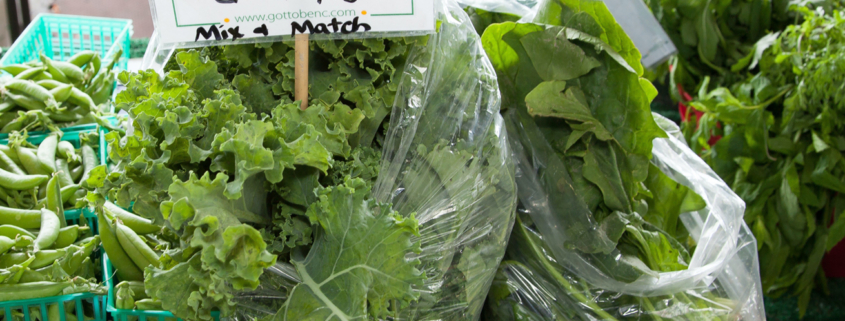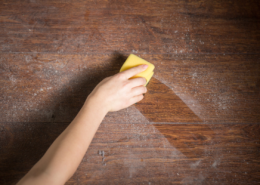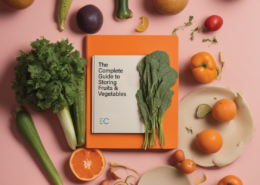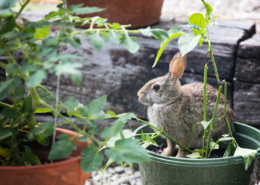The Best Way to Store Salad Greens to Make Them Last Longer
Has this happened to you? You open the refrigerator expecting to pull out the fresh, beautiful healthy salad greens you picked up at the market to get dinner on the table, only to reach in and discover a wilted, slimy mess.
That romaine, iceberg, or bag of pre-washed salad mix can’t be more than a week old, but there it is—and into the garbage, it goes. We hate when that happens—especially now as the cost of everything, including fresh produce, is soaring!
Here’s the Deal
There are ways to make salad greens last at least long enough to be consumed. But to be truly useful, whatever we have to do to make it happen needs to be practical—that means quick, easy, and reliable.
That’s why an experiment conducted at TheKitchn caught my eye and sent me running to a plastic food storage bin with a tight-fitting lid.
The Story
Christine Gallary, TheKitchn editor-at-large, was determined to end the mystery and myriad tips out there for storing salad greens by taking the three most popular methods and putting them to the test. The goal was to discover once and for all if the way we store fresh greens matters in the long run. She used a large bag of pre-washed mesclun for the test.
Method 1: Paper towel, plastic bag, no air
Lay washed greens on a paper towel, roll it up and place it inside a plastic bag, pressing out as much air as possible. Seal the bag and store it in the refrigerator crisper drawer.
Method 2: Paper towels, plastic container
Line a plastic food-storage container with paper towels, dump the greens on top of the towel, cover with another paper towel then apply a tight-fitting lid. Store the box in the refrigerator.
Method 3: Paper towel, plastic bag, yes air
Follow the same steps as Method 1, except instead of pressing out the air before sealing, blow a big puff of air into the bag to inflate it then quickly seal the bag. The idea here is that blowing into the bag introduces carbon dioxide, which supposedly helps to extend the greens’ useful life.
Here’s What Happened
After five days, Christine checked all three containers and was surprised to find very similar results. The greens in each one of the containers were still crisp, lovely, and totally edible.
After seven days, the salad greens in both of the plastic bags were beginning to show signs of wilt and some were even breaking down to the point of being inedible. But a quick pick-through would render plenty of fully-edible, lovely greens.
Turning Point
Ten days was the point at which things showed considerable differences between the storage methods.
The greens kept in plastic bags were deteriorating and becoming slimy. A lot of them were now inedible because of the excessive moisture buildup and cramped space, despite the paper towels..
But the rigid plastic storage container? The greens were still crisp, save for a few pieces that would need to be tossed out—but mostly still edible.
What Made the Difference?
The greens in the storage container were loose and never packed tightly, even from Day 1. The rigidity of the storage container protected the greens from being crushed or overly disturbed. The loose paper towels took care of the condensation.
What I like most about this is that I didn’t have to experiment! For years, I’ve enjoyed TheKitchn for all I’ve learned. Now I love it even more.
Having a plastic container designated for salad greens in my refrigerator makes so much sense. I can see inside without opening it to know what I have and how much is left. When I need lettuce or greens, it’s so easy to pop the lid, reach in, get what I need, replace it, and be done with it.
Ten-Day Window
Most of all, I am more confident now, knowing that generally, I have ten days to use up what’s in my salad bin. This Sterilite food storage bin has a tight-fitting lid, although any plastic container with a lid will work.
One of the most impressive things I find about the Sterilite products is they are made in the USA with manufacturing plants in Birmingham, Alabama, Lake Havasu City, Arizona, Massillon, Ohio, Clinton, South Carolina, Ennis, Texas; and Davenport, Iowa.
I can keep romaine, iceberg, or other types of greens that have or haven’t been pre-washed in this bin, making sure to replace the paper towel on top each time I pull something out. It’s easy and super convenient. I like this so much better than having to fuss with bags.
Other food items
Salad greens are not the only fresh food that tend to go bad before they can be fully consumed. Check out these tips and tricks to extend the life of other food items:
Cottage cheese
Any size container of cottage cheese, once opened, will last twice as long if you replace the lid then store the container upside down in the refrigerator. This creates a vacuum that pushes out some of the oxygen to create a seal. Works for sour cream, too.
Milk
Once you open that container of milk, drop in a pinch of salt then shake it up to mix well. This will not affect the taste at all but will extend the time before the milk begins to sour because salt is a bacteria inhibitor.
Cheese
Once opened and cut, wrap tightly in plastic wrap before returning to the refrigerator. Another tip: As far as possible, never touch the cheese! Always have a piece of plastic between your fingers and the cheese. You’ll see far less green mold.
Bananas
Wrap the crown (where they’re all attached) of a bunch of bananas with plastic wrap. They’ll keep for 3-5 days longer than usual—especially helpful if you eat organic bananas, which tend to ripen much more quickly.
Berries
Take berries (any kind) out of the plastic container they came in and line the container with a paper towel. Prepare a mixture of one part vinegar (white or apple cider) and ten parts water. Swirl the berries around in the mixture, rinse in a colander, and drain. Place berries back in the paper towel-lined container and store in the refrigerator.
Most berries, including raspberries, will last a week or more, and strawberries will go at least two weeks without getting moldy, soft, and ugly.
Celery, broccoli
Wrap celery (single rib or the entire stalk) or broccoli in aluminum foil before storing it in the refrigerator. It will remain crisp for four weeks or longer.
Updated 8-23-23
Everyday Cheapskate participates in the Amazon Services LLC Associates Program, an affiliate advertising program designed to provide a means for us to earn from qualifying purchases at no cost to you.
More from Everyday Cheapskate
Please keep your comments positive, encouraging, helpful, brief,
and on-topic in keeping with EC Commenting Guidelines
Last update on 2024-04-20 / Affiliate links / Images from Amazon Product Advertising API

















For greens, I chop or tear them up, rinse, spin in my salad spinner (which I would hate to live without and waited nearly 30 years to buy) and place in wide mouth mason jars. They remain fresh for days. I also shred carrots and place them in mason jars. Mason jars are becoming my “go to” in storing many vegetables.
I have been using the Blue Apple that comes with charcoal packets that you keep in your fruit & veggies drawers that you change the charcoal packets every 3 months. They really work and can be purchased at Amazon or Bed, Bath & Beyond. I also do some of the other tips mentioned above.
Love this site, thanks
For keeping greens fresh longer, I trim, wash and spin them in my salad spinner to get most of the water off, then layer between paper towels in the plastic container. They keep well and crisp a long time. I will try the idea of terry toweling instead of paper as suggested…
I store greens in a rectangular plastic container, but I don’t use paper towels with them. The container (which I bought at Walmart years ago) has a 1/4″ high plastic grill which keeps the lettuce from contacting the bottom where water can collect, and allows the greens to stay fresh for many days.
I store mushrooms in a cloth bag and they stay fresh for many weeks. I cut the core off the end of romaine lettuce and store the lettuce loosely in a plastic grocery bag (I push most of the air out) and do celery the same way. And, I always line the plastic container that my spinach comes in with a paper towel. I seldom throw anything out due to spoilage.
How many calories in the Einstein muffins?
Hi Judy … I just checked that post/recipes and was shocked to see the recipe cards had become corrupted. But all fixed now! Muffins So Amazing, They’re Insane! As to your question: one Blueberry Muffin 201 calories; one Banana Muffiin 259 calories.
Hope that helps!
I am really surprised that there is not any mention of salad spinners here. My mother-in-law used one when we went to her dinner 20 years ago. I thought she was crazy but shortly after I had a V-8 moment and bought one. OMG! you cannot make a more beautiful, fluffy, dry and tasty salad without this gadget! You don’t need any paper towels or drying the lettuce on racks…just get a salad spinner and give the salad a good hard spin! Trust me!… you will love it!
Debbie, this is an amazing deja vu! I had the exact same experience with my mother-in-law and that same V-8 moment! As I read this article I was also wondering, as you stated, why a salad spinner was not mentioned! BTW. my name is Debbie also! Love my salad spinner!!!
I use the precut/prewashed greens. We like the convenience. We also don’t eat enough to justify purchasing large quantities of salad. I dump the greens out of the bag and let them dry for a little bit on my dish rack. I line a good plastic bowl with paper towels, fill it up loosely, more paper towels on top, seal. I place the bowl upside down in the fridge. I flip it occasionally, change the paper towels once in awhile. Keeps most bagged salad really fresh for about 10-14 days. I do this with fresh vegetables, too. We have an XO lettuce keeper and salad spinner. That works great for large quantities, but we don’t use it anymore. I also try not to buy fragile salad greens unless I’m going to use them right away.
What are your thoughts on storing produce together, for example, celery with cut peppers or broccoli? Obviously, celery and carrot can be stored together. I’m thinking of 2 different veggies like green peppers etc.
I store lettuce, iceberg and romaine in glass jars. I use Veganaise (it’s like mayo but healthier) that comes in 32 oz glass jars. I buy fresh lettuce, not bagged. I rinse the lettuce, let it drain in a collander, If still really wet I put it on paper towels on a dinner plate to dry more. Then I use a jar funnel and cut the lettuce`into bite size pieces and put it in the jar. Ice berg does well cut up but with romaine I often use a long casserole dish, laying paper towel on the bottom and top of the lettuce. I eat lettuce 2-3 times a day as I have many food allergies and had Gluten Sensitivity for over 30 years before I was diagnosed in 2012, so lettuce is safe.